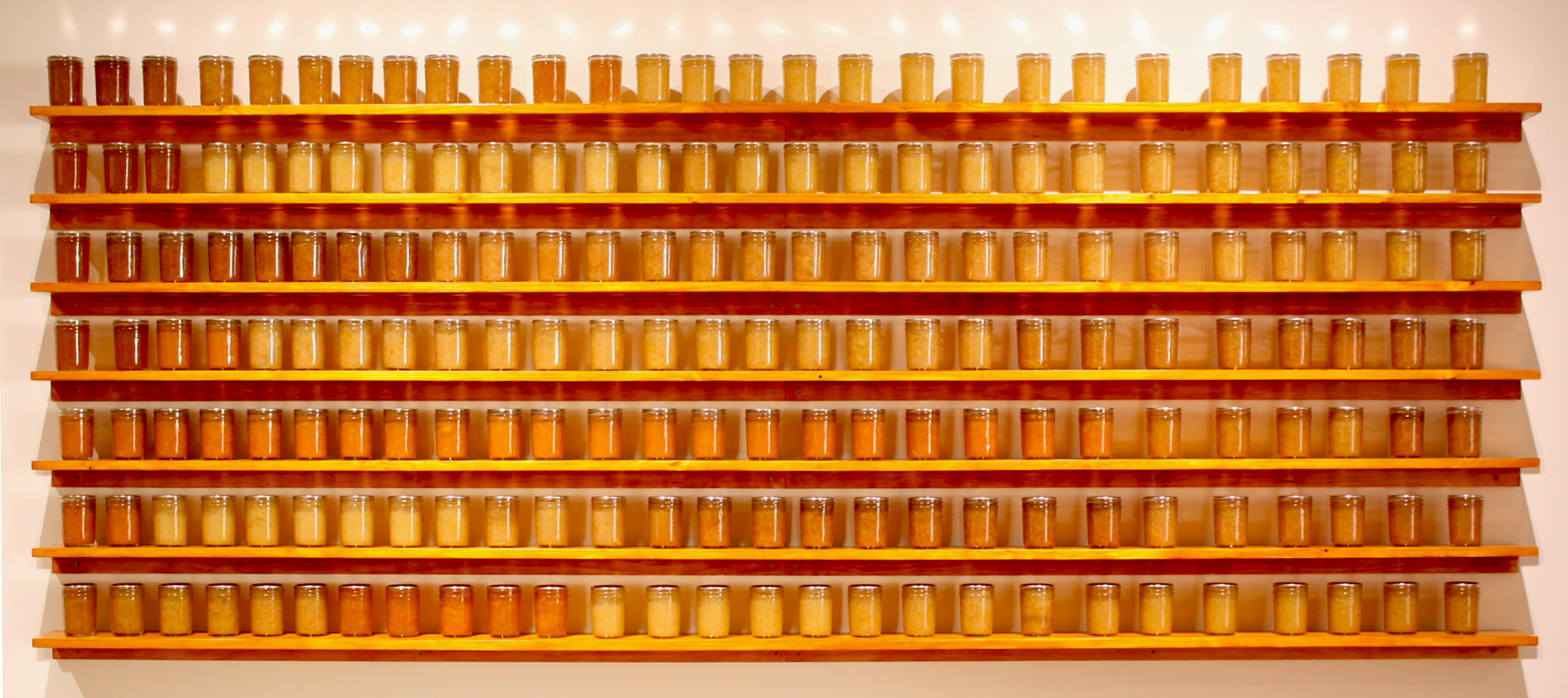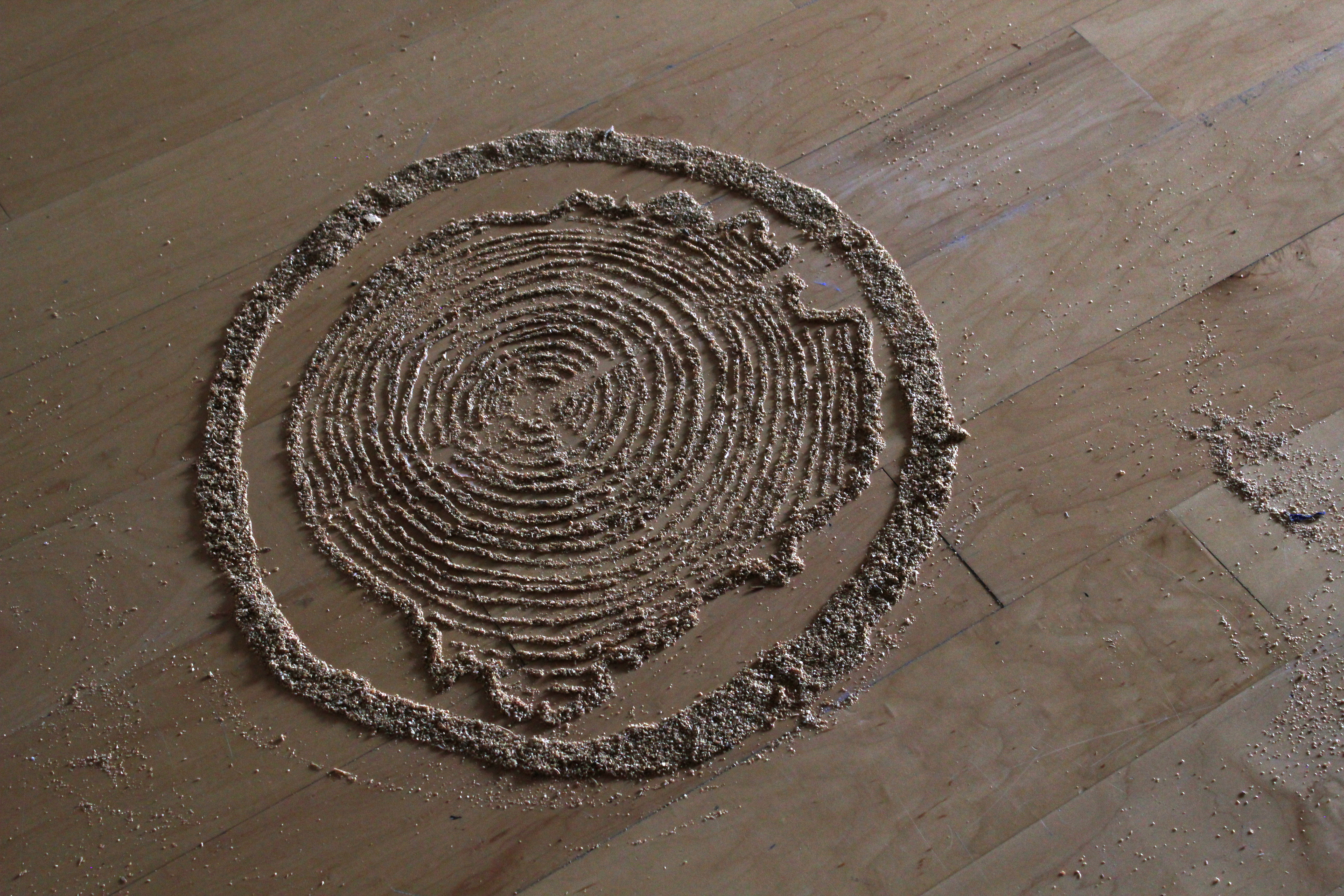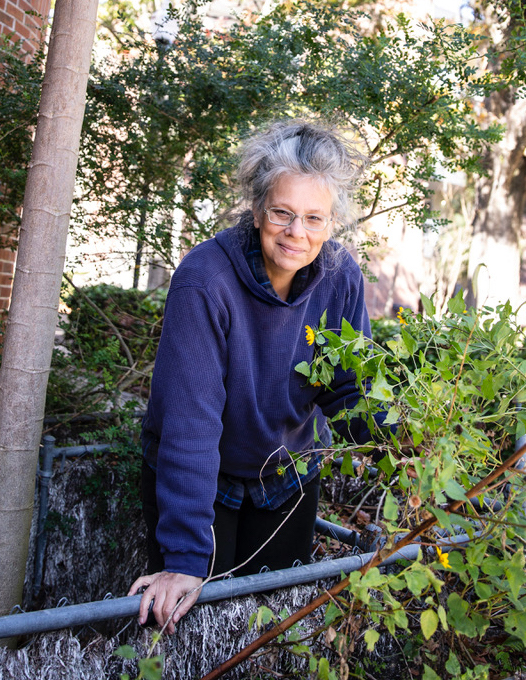 (Thy Neighbor’s Fruit, shelves, jars of jam, audio and video, 2010- now, https://vimeo.com/51706961)
(Thy Neighbor’s Fruit, shelves, jars of jam, audio and video, 2010- now, https://vimeo.com/51706961)
Active Maps Between the Trees and Me:
Katerie Gladdys Interview
by Olivia Ann Carye Hallstein
Katerie Gladdys is an alchemist of disciplines dedicated to promoting awareness of community and environmental impacts. Many of her topics are everyday objects with big histories like how your orange juice arrived on your table that morning and the circumstances that have resulted from its cultivation. But furthermore, she uses academic research to inform interactive data visualizations that are incredibly relatable like a jar of jam made from local fruit trees or through the promotion of edible weed gardens. I asked Gladdys about her depiction methods, process and how she sees the world.
Hi Katerie, so much of your work is intersectional; you bring together topics of both environment and social factors approaching fruit and local environment using both a research and creative lens. For example, in work like “Thy Neighbor’s Fruit” you gather unused fruits from neighboring trees and prepare them as jams while mapping the resources. How do you decide on how to depict your findings and integrate your community?
My art practice oscillates between local food systems and managed forests, often punctuated by investigations into the hyper local of my backyard and personal encounters with “nature.” Mapping is a methodology that allows me to vigilantly attend to the natural world at multiple and simultaneous scales. My mission and challenge as an artist to not just aestheticize data but to create meaningful visualizations connected to the data, but also to conversations about art.
For instance, in Thy Neighbor’s Fruit, ideas about mass production, overlooked resources and waste comingle with serialization, the multiple, color theory and even the idea of a mosaic. The installation has audio and/or video where the people who contributed the fruit for the jam discuss their relationship to their trees, food preservation and family stories about growing food. The jars of jam and the stories feel familiar even comforting, but the presentation and context perhaps invites further thought about gendered labor and food systems. One audience engagement that I find particularly gratifying with this piece was an elderly woman who surreptitiously picked up the jars to see if the jam had set. Or how the jam often enters exchange and gift economies as food post-exhibition.

(Eccentric Grids: Mapping the Managed Forest: Enumeration and Density, small format video, custom electronics, sawdust, 2017-ongoing)
You mention mapping, which you often use as a way of articulating your research. And your presentations of what maps can be are varied and integrative. What work have you made that speak especially to the goal of “meaningful visualizations connected to the data?”
In Eccentric Grids: Mapping the Managed Forest: Enumeration and Density, I researched the tree density of managed commercial pine plantations harvesting for both pulp for paper products and board lumber with the natural spacing of the “trunk print” of old growth longleaf pine forests. I laid out the trunk prints of pulp, board and old growth trees in the scaled grids in which they are planted in a managed pine plantation or occur “naturally” in pre-settlement forests maintained by indigenous people. Each trunk print is a stencil of sawdust, an ephemeral by-product of chopping down a tree, that marks the trace of each tree. The audience is allowed to walk amongst the trunk prints and I often expect and plan for the piece to be obliterated during the time span of the exhibition. But often, most of the stencils remain intact suggesting much care and mindfulness of those walking through the visualization of the forest.

(Seed Cabinet, repurposed card catalog, custom electronics, video, and seeds, 28” x 18” x 38”, 2018-ongoing, https://vimeo.com/224731846 )
Wonderful. It is incredible how many elements you integrate into your process, and I wonder if this has to do with your academic research. For example, you often integrate your research into your artistic development like in the Agent Orangerie analysis of both consumer and production patterns in orange juice manufacturing and the resulting work, "Thy Neighbor's Fruit". In what ways does your academic work intersect and inform your artistic process?
I am very fortunate to teach at a land grant research institution. My research practice is very experiential yet informed by academic research. How people “do science” in an institutional setting becomes a space of play and potential critique. If one uses the metaphor of a recipe to think about scientific method and data, a research-based art practice uses the data and methods to redirect and comment upon the larger social context created by academic research. I am lucky to be able to go and have conversations with colleagues whose life’s work is thinking about food security or managed forests or to be able to go and look at seeds from endangered native plants growing in a lab. I get to see a lot of stuff and talk with interesting people.

(Seed Cabinet, repurposed card catalog, custom electronics, video, and seeds, 28” x 18” x 38”, 2018-ongoing, https://vimeo.com/224731846 )
What a unique and fruitful community you have found! No wonder this theme of community is very present in what you have exhibited. As both environmental research, presentation, and interactive design, many of your works engage the public through both awareness and activation (ex. Forest art collab, seed cabinet). What is your mission in creating this novel intersection and have audience members engaged after the initial viewing?
I endeavor to make art that awakens the curiosity in my viewers: transforming spectators into participants yearning to explore their surrounding environments. For example, in Seed Cabinet, opening each drawer of repurposed card catalog triggers the playing of videos and audio narratives that depict the community’s living intertwined relationships with these plants. Seed Cabinet collides the ordered worlds of science and libraries with the messiness of soil and plants, sowing the seeds for dialog. This piece invites the audience to engage with stories that describe personal and cultural relationships with the vegetal world told by those whose lives are profoundly intertwined with plants and agriculture. Seed Cabinet operates on multiple levels—sculptural object, performative installation, and participates in hands-on educational and community events, international conferences and symposiums. Interacting with both seeds and card catalogs is sensual and tactile, an active experience and a call to dialog and action to manifest further engagement with food systems in the form of learning about alternative food sources and cultivating gardens.

(Seed Cabinet, repurposed card catalog, custom electronics, video, and seeds, 28” x 18” x 38”, 2018-ongoing, https://vimeo.com/224731846 )
Now you’re talking my language! I was particularly interest in your “Green Lining?” and “Sanctuary” work that take a strong stance in favor of “weeds” as gardens themselves, especially the edible ones! What would an ideal inhabited landscape look to you?
An ideal inhabited landscape is one that sustains a diversity of species including humans and recognizes the sentience of those other-than-humans. That being said I live in what used to be rural north central Florida, a rapidly changing landscape, where the timber forests and agricultural lands that succeeded pre-settlement long leaf pine ecosystems and coastal wetlands, vanish daily replaced at an alarming rate by homogeneous suburban sprawl. I have difficulty processing and literally finding my way in the midst of the weekly destruction of green space resulting from exponential development due to the increasing population of Florida and inland “development” perhaps expecting salinization and rising sea levels. I am left to focus on the ruderal ecologies of what persists and supplants what came before. Weeds are resilient, often invasive plants that may function as potential food sources in a changing climate. I am working on another iteration of Seed Cabinet that invites the audience to re-examine ubiquitous ecosystems as speculative nutrition in a warming world and to question the notion, "What is a weed?" Many “weeds” local to north central Florida are heritage vegetables in diaspora and indigenous communities and are connected to stories of survival and immigration.
Thank you, Katerie, for a wonderful interview.

Katerie Gladdys is a transdisciplinary artist who thinks about place, marginalized landscapes, sustainability, mapping, consumption, food, agriculture, and disability. She creates installations, interactive, sculpture, video, and relational performances. She is currently an associate professor in Art and Technology in the School of Art and Art History at the University of Florida. Recent partners in collaboration include Working Food, a non-for-profit that educates people about sustainability and local food, University of Florida School of Forest Resource and Conservation, and the Gainesville community. Prior to joining the faculty at University of Florida, Gladdys was the multimedia education coordinator at University of Illinois at Springfield. She served as an educator at the Virginia Museum of Fine Art traveling to rural counties with the Artmobile teaching K-12 workshops as well as creating exhibition programming. She received her MFA in New Media from the University of Illinois at Urbana-Champaign and a BA in Art and Design from the University of Chicago. She also has an MA in Teaching English to Speakers of Other Languages with a specialization in pragmatics and discourse from Southern Illinois University at Carbondale. layoftheland.net